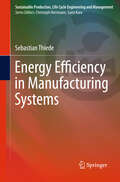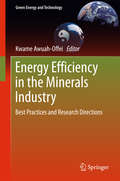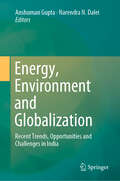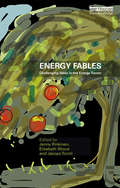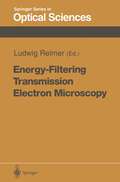- Table View
- List View
Energy Efficiency Improvements in Electric Motors and Drives
by Anibal De Almeida Paolo Bertoldi Werner LeonhardThe reduction of energy consumption through improvements in energy efficiency has become an important goal for all countries, in order to improve the efficiency of the economy, to increase energy supply security, and to reduce the emissions of CO and other pollutants caused by power· generation. 2 Electric motors use over half of all electricity consumed in developed countries. Typically 60-80% of the electricity which is used in the industrial sector and about 35% of the electricity used in the commercial sector in the European Union is consumed by motors. In industry, a motor consumes an annual quantity of electricity which corresponds to approximately 5 times its purchase price, throughout its whole life of aroun~ 12 to 20 years. Motors are by far the most important type of electric load. They are used in all sectors and in a wide range of applications, namely the following: fans, compressors, pumps, mills, winders, elevators, transports, home appliances, and office equipment, etc. It is their wide use that makes motor drive systems one of the main targets to achieve significant energy savings. As motors are the largest USers of electrical energy, even small efficiency improvements will produce very large energy savings.
Energy Efficiency in Domestic Appliances and Lighting: Proceedings of the 10th International Conference (EEDAL'19) (Springer Proceedings in Energy)
by Paolo BertoldiThis book contains peer-reviewed papers presented at the 10th International Conference on Energy Efficiency in Domestic Appliances and Lighting (EEDAL'19), held in Jinan, China from 6-8 November 2019.Energy efficiency helps to mitigate CO2 emissions and at the same time increases the security of energy supply. Energy efficiency is recognized as the cleanest, quickest and cheapest energy source. Not only this, but energy efficiency brings several additional benefits for society and end-users, such as lower energy costs, reduced local pollution, better outdoor and indoor air quality, etc.However, in some sectors, such as the residential sector, barriers to investments in energy efficiency remain. Legislation adopted in several jurisdictions (EU, Japan, USA, China, India, Australia, Brazil, etc.) helps in removing barriers and fosters investments in energy efficiency. These initiatives complement innovative financing schemes for energy efficiency, the provision of energy services by energy service companies and different types of information programs. At the same time, progress in appliance technologies and in solid state lighting offer high levels of efficiency. LED lighting is an example. As with previous conferences in this series, EEDAL’19 provided a unique forum to discuss and debate the latest developments in energy and environmental impact of households, including appliances, lighting, heating and cooling equipment, electronics, smart meters, consumer behavior, and policies and programs. EEDAL addressed non-technical issues such as consumer behavior, energy access in developing countries, and demand response.
Energy Efficiency in Household Appliances: Proceedings of the First International Conference on Energy Efficiency in Household Appliances, 10–12 November 1997, Florence, Italy
by Paolo Bertoldi Andrea Ricci Boudewijn Huenges WajerThere is widespread interest throughout the world in improving appliance energy efficiency. Methods to reach that end include energy labeling, energy efficiency standards and market conditioning (e.g, energy efficient procurement and DSM programs). Energy efficiency standards, which started out as an action to reduce demand for energy in individual countries, has now become a subject of regional and even worldwide dimension, particularly in the context of global climate change mitigation. Mandatory energy efficiency standards are in place for some appliances in China, Canada, Mexico, the Philippines and the United States. Standards for refrigerator/freezers will take effect in Australia and the European Union in 1999. Voluntary energy efficiency standards are in place for refrigerators in Brazil, India and Korea and for air conditioners in India, Japan and Korea. Table I showed potential global energy use reductions from codes and standards in buildings. If individual country data can be assembled, a more accurate approach to estimating potential reductions in energy use and carbon emissions would be to perform a bottom-up analysis for energy using equipment on an end-use basis in as many large developing countries as possible. The impact of standards would be assessed as more efficient appliances replaced existing stock models and new purchases that increased saturation rates were made at higher efficiencies than would otherwise be the case. This approach would show the slow but steady buildup of annual energy savings from efficiency standards or other programs to improve energy efficiency.
Energy Efficiency in Manufacturing Systems (Sustainable Production, Life Cycle Engineering and Management)
by Sebastian ThiedeEnergy consumption is of great interest to manufacturing companies. Beyond considering individual processes and machines, the perspective on process chains and factories as a whole holds major potentials for energy efficiency improvements. To exploit these potentials, dynamic interactions of different processes as well as auxiliary equipment (e.g. compressed air generation) need to be taken into account. In addition, planning and controlling manufacturing systems require balancing technical, economic and environmental objectives. Therefore, an innovative and comprehensive methodology – with a generic energy flow-oriented manufacturing simulation environment as a core element – is developed and embedded into a step-by-step application cycle. The concept is applied in its entirety to a wide range of case studies such as aluminium die casting, weaving mills, and printed circuit board assembly in order to demonstrate the broad applicability and the benefits that can be achieved.
Energy Efficiency in Motor Driven Systems
by Francesco Parasiliti Paolo BertoldiThis book reports the state of the art of energy-efficient electrical motor driven system technologies, which can be used now and in the near future to achieve significant and cost-effective energy savings. It includes the recent developments in advanced electrical motor end-use devices (pumps, fans and compressors) by some of the largest manufacturers. Policies and programs to promote the large scale penetration of energy-efficient technologies and the market transformation are featured in the book, describing the experiences carried out in different parts of the world. This extensive coverage includes contributions from relevant institutions in the Europe, North America, Latin America, Africa, Asia, Australia and New Zealand.
Energy Efficiency in Process Technology
by P. A. PilavachiSince 1975 the Commission has been stimulating R & D work aimed at energy saving. The conference objective was to provide an international forum for the presentation and discussion of recent R & D relevant to energy efficiency, taking into account environmental aspects, in the energy intensive process industries.
Energy Efficiency in the Minerals Industry: Best Practices and Research Directions (Green Energy and Technology)
by Kwame Awuah-OffeiThis book presents a state-of-the-art analysis of energy efficiency as applied to mining processes. From ground fragmentation to mineral processing and extractive metallurgy, experts discuss the current state of knowledge and the nagging questions that call for further research. It offers an excellent resource for all mine managers and engineers who want to improve energy efficiency to boost both production efficiency and sustainability. It will also benefit graduate students and experienced researchers looking for a comprehensive review of the current state of knowledge concerning energy efficiency in the minerals industry.
Energy Efficiency in the Urban Environment
by Heba Allah Khalil Essam E. KhalilEnergy Efficiency in the Urban Environment is a study of energy crisis, urbanisation, and climate change, as well as a discussion of how to combat these global challenges. With a special focus on Egypt, this book addresses the macroscale of urbanism from the perspective of city dwellers' quality of life, and explores the microscale of buildings and
Energy-Efficient Fault-Tolerant Systems (Embedded Systems Ser.)
by Jimson Mathew Rishad A. Shafik Dhiraj K. PradhanThis book describes the state-of-the-art in energy efficient, fault-tolerant embedded systems. It covers the entire product lifecycle of electronic systems design, analysis and testing and includes discussion of both circuit and system-level approaches. Readers will be enabled to meet the conflicting design objectives of energy efficiency and fault-tolerance for reliability, given the up-to-date techniques presented.
Energy-Efficient HVAC Design: An Essential Guide for Sustainable Building
by Javad KhazaiiThis book provides readers with essential knowledge enabling the successful design of today's new energy efficient HVAC systems. The author introduces important concepts such as Knowledge Categorization, Performance Based Design Standards, and Quantification of Uncertainty in Energy Modeling for Buildings. Pivotal topics that all HVAC and architectural engineers must master in order to navigate the green building renaissance are given focused attention, including the role of renewables, air quality, automatic controls, and thermal comfort. Relevant ASHRAE standards, as well as sustainability scoring systems such as BREEAM, HQE, LEED and CASBEE are explained in depth. Armed with the material contained in this practical reference, students and practitioners alike will become more effective and prepared for engineering success.
Energy Efficient Non-Road Hybrid Electric Vehicles: Advanced Modeling and Control (SpringerBriefs in Applied Sciences and Technology)
by Johannes Unger Marcus Quasthoff Stefan JakubekThis book analyzes the main problems in the real-time control of parallel hybrid electric powertrains in non-road applications that work in continuous high dynamic operation. It also provides practical insights into maximizing the energy efficiency and drivability of such powertrains. It introduces an energy-management control structure, which considers all the physical powertrain constraints and uses novel methodologies to predict the future load requirements to optimize the controller output in terms of the entire work cycle of a non-road vehicle. The load prediction includes a methodology for short-term loads as well as cycle detection methodology for an entire load cycle. In this way, the energy efficiency can be maximized, and fuel consumption and exhaust emissions simultaneously reduced. Readers gain deep insights into the topics that need to be considered in designing an energy and battery management system for non-road vehicles. It also becomes clear that only a combination of management systems can significantly increase the performance of a controller.
Energy Efficient Solvents for CO2 Capture by Gas-Liquid Absorption: Compounds, Blends and Advanced Solvent Systems (Green Energy and Technology)
by Wojciech M. BudzianowskiThis book reviews and characterises promising single-compound solvents, solvent blends and advanced solvent systems suitable for CO2 capture applications using gas-liquid absorption.Focusing on energy efficient solvents with minimal adverse environmental impact, the contributions included analyse the major technological advantages, as well as research and development challenges of promising solvents and solvent systems in various sustainable CO2 capture applications.It provides a valuable source of information for undergraduate and postgraduate students, as well as for chemical engineers and energy specialists.
Energy Efficient Thermal Management of Data Centers
by Yogendra Joshi and Pramod KumarEnergy Efficient Thermal Management of Data Centers examines energy flow in today's data centers. Particular focus is given to the state-of-the-art thermal management and thermal design approaches now being implemented across the multiple length scales involved. The impact of future trends in information technology hardware, and emerging software paradigms such as cloud computing and virtualization, on thermal management are also addressed. The book explores computational and experimental characterization approaches for determining temperature and air flow patterns within data centers. Thermodynamic analyses using the second law to improve energy efficiency are introduced and used in proposing improvements in cooling methodologies. Reduced-order modeling and robust multi-objective design of next generation data centers are discussed.
Energy Engineering: Proceedings of CAETS 2015 Convocation on Pathways to Sustainability
by K. V. Raghavan Purnendu GhoshThis book contains the proceedings of CAETS 2015 Convocation on ‘Pathways to Sustainability: Energy, Mobility and Healthcare Engineering’ that was held on October 13-14, 2015 in New Delhi. This 3 volume proceedings provide an international forum for discussion and communication of engineering and technological issues of common concern. This volume talks about ‘Energy’ and includes 22 chapters on diverse topics like renewable energy, advances and applications of bio-energy and bio-refinery, energy options and scenarios, wind energy for buildings and transportation, etc. The contents of this volume will be useful to researchers, professionals, and policy makers alike.
Energy, Entropy, and the Flow of Nature
by Thomas F. ShermanEnergy, Entropy, and the Flow of Nature presents the essential principles of energetics (thermodynamics) in a straight-forward, easy to understand, and logically-consistent manner. As a student of physical chemistry and as a professor and researcher in biochemistry, physiology, and general biology, the author has seen the problems that arise for students, teachers, and researchers in mastering the laws of thermodynamics. These difficulties can be alleviated by a careful consideration of the historical roots of the ideas involved, and by recognizing that all natural change can be understood as a flow across a gradient of some kind. Part of the effect of every flow is to diminish its own gradient, but the decrease of one gradient can drive an increase in another. The book's mission is to build a solid understanding of the fundamental concepts of energetics and a confidence in going forth into the many areas that the study of energy opens up. In their applications, the laws of energy and entropy can often involve highly challenging problems and calculations, but the fundamental concepts addressed in this book are easy to understand and require relatively little mathematics.
Energy, Environment and Globalization: Recent Trends, Opportunities and Challenges in India
by Anshuman Gupta Narendra N. DaleiThis book analyzes contemporary issues relating to energy, environment, and globalization in the Indian context. As a signatory to the Paris climate accord, India has reiterated its commitment to taking strong and positive steps toward climate change mitigation. However, as one of the fastest growing economies in the world, it is battling the effects of a steep rise in fossil fuel usage and pollution. Further, increasing globalization is leading to greater economic activity and production, resulting in additional energy use, which has a negative effect on the environment. The book argues that globalization need not have only a negative environmental impact; it can also have positive impact through the importation of environmentally sound technologies and implementing global compliance standards. The book is divided into three sections: The energy section discusses issues relating to the status of Indian natural gas market and the need for developing an efficient gas market in India; the economics and politics of sustainable energy in India; the challenges of thermal power and significance of clean thermal power generation in India; environmental and policy issues concerning energy use in urban India; the importance of energy use in developing Human Development Index (HDI); and issues relating to renewable energy in India. The environment section then examines topics such as the impact of global warming on local weather by examining the frequency of extreme weather events such as drought and floods, and their impact on farming activities in the Indian state of Odisha; the importance of according the economic value to environmentally significant things like national park , mangroves, etc. for sustainable development; the role of environmental accounting for ecological sustainability and ecotourism; and environmental concerns increasingly gaining traction among the corporate sector for their long-run benefits . Lastly, the third section addresses issues relating to the challenges and opportunities of globalization, such as the interface between globalization and environment; managing India’s business interest in proposing new Bilateral Investment Treaty (BIT); the challenges being faced by Indian exports and their revival; and making Indian SMEs competitive. As such, it is an invaluable resource for policymakers, researchers, practitioners and students in the field of energy, environment and trade economics.
Energy, Environment and Green Building Materials: Proceedings of the 2014 International Conference on Energy, Environment and Green Building Materials (EEGBM 2014), November 28-30, 2014, Guilin, Guangxi, China
by Dawei Zheng Ai ShengThe 2014 International Conference on Energy, Environment and Green Building Materials (EEGBM2014) was held November 28-30, 2014, in Guilin, Guangxi. EEGBM2014 provided a valuable opportunity for researchers, scholars and scientists to exchange their new ideas and application experiences face to face together, to establish business or research relat
Energy, Environment and Sustainable Development
by Mohammad Aslam Aslam Uqaili and Khanji HarijanNew information and strategies for managing the energy crisis from the perspective of growing economies are presented. Numerous case studies illustrate the particular challenges that developing countries, many of which are faced with insufficient resources, encounter. As a result, many unique strategies to the problems of energy management an conservation, environmental engineering, clean technologies, biological and chemical waste treatment and waste management have been developed.
The Energy Evolution – Harnessing Free Energy from Nature: Volume 4 of Renowned Environmentalist Viktor Schauberger’s Eco-Technology Series (Eco-technology Ser.)
by Viktor SchaubergerThe Energy Evolution, the final volume in the revolutionary Eco-Technology series, contains radical environmentalist Viktor Schauberger’s groundbreaking writings on methods for energy generation that harness the enormous potential of Nature. Nature produces energy by slow, cool, implosive means – by a centripetal inward motion, while our present culture uses explosive centrifugal (outwards) movement, which is wasteful and many times less powerful and effective. It also uses up the Earth’s resources and pollutes her ecosystems. This volume describes different kinds of energy machines which depend on the principle of implosion:A spring water-producing machineA tornado home energy generatorA Klimator which produces mountain-quality airThe biotechnical submarineA technique for producing power from ocean deepsA flying saucer prototype which rose at fantastic speed to high altitudesA perpetual motion suction-based implosion machineOne of the first genuine environmentalists, Schauberger was a pioneering genius who combined keen observation of Nature with intuitive brilliance and a sharp engineer’s brain. His work is enjoying a worldwide revival because he was able to convey how an understanding of Nature’s subtle energies is essential to our survival. This Fertile Earth contains his innovative theories as well as his very last letters on the subject, providing an alternative analysis of the unharnessed and vital power of Nature. The Eco-Technology series makes available for the first time Viktor Schauberger’s original writings and passionate debates. Callum Coats has painstakingly collected, translated and edited the material for what promises to be the most definitive study yet of this extraordinary man’s life and work.This Fertile Earth: Table of ContentsIntroductionSome Philosophical Aspects of Natural EnergiesNew Forms of TemperatureNew Forms of Motion and EnergyNew Views of ElectromagnetismThe Nature of Water, its Conduction and Use for TransportThe Air TurbineEarly Developments in Implosion MachinesThe Ennoblement of WaterMachines of the Genus – RepulsatorThe KlimatorMachines of the Genus – RepulsineLast Letters from Viktor SchaubergerThe Popel Report
Energy Fables: Challenging Ideas in the Energy Sector
by Jenny Rinkinen Elizabeth Shove Jacopo TorritiEnergy Fables: Challenging Ideas in the Energy Sector takes a fresh look at key terms and concepts around which energy research and policy are organised. Drawing on recent research in energy and transport studies, and combining this with concepts from sociology, economics, social theory and technology studies, the chapters in this collection review and challenge different aspects of received wisdom. Brief but critical introductions to classic notions like those of ‘energy efficiency’, ‘elasticity’, ‘energy services’ and the ‘energy trilemma’, together with discussions and analyses of well-worn phrases about ‘low hanging fruit’ and ‘keeping the lights on’, articulate aspects of the energy debate that are often taken for granted. In re-working these established themes and adding twists to familiar tales, the authors develop a repertoire of new ideas about the fundamentals of energy demand and carbon reduction. This book presents a valuable and thought-provoking resource for students, researchers and policy-makers interested in energy demand, politics and policy.
Energy Fables: Challenging Ideas in the Energy Sector
by Jenny Rinkinen Elizabeth Shove Jacopo TorritiEnergy Fables: Challenging Ideas in the Energy Sector takes a fresh look at key terms and concepts around which energy research and policy are organised. Drawing on recent research in energy and transport studies, and combining this with concepts from sociology, economics, social theory and technology studies, the chapters in this collection review and challenge different aspects of received wisdom. Brief but critical introductions to classic notions like those of ‘energy efficiency’, ‘elasticity’, ‘energy services’ and the ‘energy trilemma’, together with discussions and analyses of well-worn phrases about ‘low hanging fruit’ and ‘keeping the lights on’, articulate aspects of the energy debate that are often taken for granted. In re-working these established themes and adding twists to familiar tales, the authors develop a repertoire of new ideas about the fundamentals of energy demand and carbon reduction. This book presents a valuable and thought-provoking resource for students, researchers and policy-makers interested in energy demand, politics and policy.
Energy-Filtering Transmission Electron Microscopy (Springer Series in Optical Sciences #71)
by P. W. Hawkes C. Deininger R. F. Egerton F. Hofer B. Jouffrey D. Krahl R. D. Leapman J. Mayer Ludwig Reimer H. Rose P. Schattschneider J.C.H. SpenceEnergy-Filtering Transmission Electron Microscopy (EFTEM) presents a summary of the electron optics, the electron-specimen interactions, and the operation and contrast modes of this new field of analytical electron microscopy. The electron optics of filter lenses and the progress in the correction of aberrations are discussed in detail. An evaluation of our present knowledge of plasmon losses and inner-shell ionisations is of increasing interest for a quantitative application of EFTEM in materials and life sciences. This can be realized not only by filtering the elastically scattered electrons but mainly by imgaging and analyzing with inelastically scattered electrons at different energy losses up to 2000 eV. The strength of EFTEM is the combination of the modes EELS, ESI, ESD and REM.
Energy Flow Theory of Nonlinear Dynamical Systems with Applications (Emergence, Complexity and Computation #17)
by Jing Tang XingThis monograph develops a generalised energy flow theory to investigate non-linear dynamical systems governed by ordinary differential equations in phase space and often met in various science and engineering fields. Important nonlinear phenomena such as, stabilities, periodical orbits, bifurcations and chaos are tack-led and the corresponding energy flow behaviors are revealed using the proposed energy flow approach. As examples, the common interested nonlinear dynamical systems, such as, Duffing’s oscillator, Van der Pol’s equation, Lorenz attractor, Rössler one and SD oscillator, etc, are discussed. This monograph lights a new energy flow research direction for nonlinear dynamics. A generalised Matlab code with User Manuel is provided for readers to conduct the energy flow analysis of their nonlinear dynamical systems. Throughout the monograph the author continuously returns to some examples in each chapter to illustrate the applications of the discussed theory and approaches. The book can be used as an undergraduate or graduate textbook or a comprehensive source for scientists, researchers and engineers, providing the statement of the art on energy flow or power flow theory and methods.
Energy Flows, Material Cycles and Global Development: A Process Engineering Approach to the Earth System (Environmental Science and Engineering)
by Georg Schaub Thomas TurekThis book starts by discussing the global flows of energy and materials and changes caused by human activities. It then examines the limitations of anthropogenic energy and material flows and the consequences for the development of human society. Different scenarios for lifestyle patterns are correlated with the future development of the global energy supply and climate. As it provides a process engineering approach to the Earth system and global development, readers should have a basic understanding of mathematics, physics, chemistry and biology.This second edition also reflects new developments since the original publication: increases in anthropogenic energy and material flows due to significant economic growth in certain parts of the world, and recent changes in energy policy and technological development countries, such as Germany (the Energiewende, or transition to renewable energy sources), where goals have been defined and measures initiated for a future energy supply without fossil and nuclear sources. As such, it offers a valuable resource for undergraduate and graduate students as well as practicing experts alike.
Energy Flows, Material Cycles and Global Development: A Process Engineering Approach to the Earth System (Environmental Science and Engineering)
by Georg Schaub Thomas TurekThe book deals with the global flows of energy and materials, and changes caused by human activities. Based on these facts, the limitations of anthropogenic energy and material flows and the resulting consequences for the development of human societies are discussed. Different scenarios for lifestyle patterns are correlated with the world´s future development of energy supply and climate. The book provides a process engineering approach to the Earth system and global development. It requires basic understanding of mathematics, physics, chemistry and biology, and provides an insight into the complex matter for readers ranging from undergraduate students to experts.



